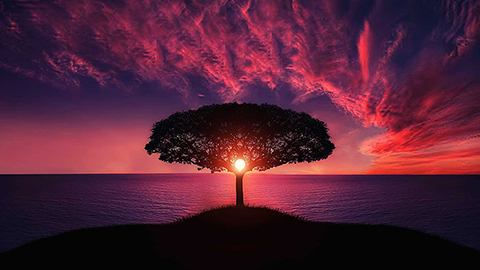
By Jerry Kvasnicka
The history of religion is nothing more than the history of the various symbols used to represent the divine reality. The religions of the world have often been described as different pathways to the summit of the same mountain, alike insofar as they all seek the supreme reality of God but different insofar as their respective approaches to God are concerned.
The approaches are different because the symbols employed to focalize the divine reality in human consciousness are different. (Symbols are used here in their broadest sense to include all sacred objects, rituals, creeds, systems, practices, etc.; in other words, all of the observable phenomena of a religion.)
Living faith maintains a dynamic balance between the religious reality and its symbolic manifestations. Living faith moves inward and upward toward the reality but simultaneously moves outward to express itself in living symbols. However, in the religions and spiritual practices created by human beings, this creative interchange of symbol and reality is generally absent.
There are religions so preoccupied with deity that symbolic expression becomes superfluous, and there are religions so intoxicated with their own symbols that the divine reality which the symbols were originally intended to signify is no longer experienced. Eastern mystical religions, particularly Zen Buddhism, might be cited as vulnerable to the first tendency, while Western religion, particularly Christianity, is a victim of the latter.
Going within is not enough
If religion is defined in terms of a divine reality and its symbolic expression in the world of form, then it may be questioned whether the Eastern approach of going within, with its general indifference to religious symbols, is a religion at all. It is more like a psychological exercise or centering technique, the goal of which is timeless union with “the One.”
The practitioner of Zen may spend long hours in disciplined meditation to empty the mind of interfering thoughts and feelings and break all attachments to the material world. This process, if successful, culminates in nirvana—“the state of perfect blessedness achieved by the extinction of individual existence and the absorption of the soul into the supreme spirit.”
But if the meaning of life is solely in the One, then we may well ask, “Why the many?” Doesn’t the very existence of “the many” imply that the purpose of life is the unfoldment of the One in the many, not the annihilation or the absorption of the many by the One? It would be odd if the created world had no other reason for being than to return to that out of which it was created! Isn’t the Eastern yogi who endeavors to spend every moment of his waking existence in rapt contemplation of the One being as false to life as the Western materialist caught in the web of externals?
When, after rigorous meditation, an individual feels he is directly contemplating the “the Source of Being,” he often describes it as totally devoid of qualities, as undifferentiated light, as “absolute nothingness.” Of course! What is the whole without its parts? The West’s lingering suspicion of Eastern religion is understandable. The One does indeed become a void without the many. Surely we are not on Earth to somehow get out of the Earth and back into heaven, but rather to let the things of heaven come into the Earth, to let the essences concentrated in the higher vibratory levels be magnified in visible symbols of their beauty and perfection.
Symbols made into idols die
But when faith moves outward in symbolic expression, another danger arises. Traditions rich in symbolism—and this certainly includes Western rational, historical and ethical religions—have succumbed to the temptation to make idols out of their symbols. Living symbols always point beyond themselves to something higher. A symbol dies when it is proclaimed to be holy in and of itself; that is, when an individual manifestation of ultimate reality is represented as embodying the fullness of that reality and is worshiped accordingly.
Western religion has a long and tragic history of just such idolatry. It is a sad and tedious chronicle of devout men and women who terminated their usefulness to divine purpose by making idols out of their symbols. And, of course, the outstanding example in this regard involves the human attempts to interpret the person and work of Jesus Christ.
There is probably no manifestation of being in the history of this planet that could with greater justification be called a living symbol of divine reality than Jesus. But as early as Peter and Paul, the original simplicity and self-effacing character of this symbol began to be lost in a proliferation of words and rituals. After two or three centuries of tampering by the human mind, the symbol was so encrusted with Trinitarian formulas, atonement theories and elaborate ethical and eschatological teachings as to be scarcely recognizable.
Worship God, not Jesus
We never find Jesus the man laying claims to exclusive representation of ultimate reality. He consistently pointed beyond himself to the Father. “The words that I speak unto you I speak not of myself: but the Father that dwelleth in me, he doeth the works.”
But shortly after his departure from this sphere, and to a certain extent even while he was still on Earth, his disciples and other followers began to build an idol. The vehicle through which the higher level of reality manifested was declared to be the reality itself; symbol was confused with source, was worshiped as such, and was represented as effective in securing “the salvation of the human soul.” So did Christianity, the outgrowth of this process, die before it even began.
Another instance in the tradition of Christianity where symbols been elevated to the status of absolutes and regarded as effective in and of themselves for achieving human salvation is in the Roman Catholic doctrine of the “transubstantiation” of bread and wine, during the ceremony of the Eucharist, into the body and blood of Christ. Because faith is so often centered in the symbols rather than in the reality they allegedly represent, merely ingesting the sacred elements is thought to effect some sort of magical transformation quite apart from the communicant’s personal recognition of and relationship with the divine reality. Genuine worship of the holy is replaced by a rather narrow preoccupation with the benefits to mind and body of the “supernatural elements.”
The dangers of symbolic crystallization
There are countless ways, many of them very subtle and seemingly innocuous, in which the power of symbols to convey the presence of the holy has been distorted into gross idolatry. In many cases the idols have been worshiped and otherwise maintained long after the death of the original symbols. Symbols die when they are treated as absolutes that embalm the spirit of God rather than as disposable containers that are useful to spirit for a season and then are discarded in the interest of letting all things be made new.
Life, after all, is an ever-changing creative dynamic and ceases to move through symbols developed by human beings to crystallize its expression. Yet, particularly in the religious traditions of the West, symbols relevant for a given time and place, for the social and cultural matrix of one age, have been stubbornly carried over into succeeding historical periods, often producing outrageous and almost comical anachronisms.
The Christianity characteristic of the Western world has refused again and again to relinquish symbols that have outlived their usefulness as creative carriers of higher reality, especially when these symbols are creedal statements and elaborate theological systems produced by the human mind. The consequence of this crystallizing process has been the loss of what was earlier described as “a dynamic balance between the religious reality and its symbolic manifestations.” The contemporary religious situation the West might be described as a growing pile of dead and decaying symbols.
Living symbols
Upon encountering a valley of dry bones in his vision, the prophet Ezekiel was asked, “Son of man, can these bones live?” Observing the present state of world disintegration, one might similarly wonder if life will ever move again through living symbols on Earth, symbols that communicate rather than crystallize its expression. There was a time when they lived, a time when “the morning stars sang together, and all the sons of God shouted for joy.” What is required for living symbols to thrive and multiply once again on Earth? Perhaps a clue to the answer may be found as we review the nature and purpose of living symbols.
Symbols share with signs the characteristic of pointing beyond themselves to something else. But while symbols participate in the reality to which they point, signs do not. A living symbol is transparent to the divine reality; to be in the presence of the symbol is to be in the presence of the reality. However, because such symbols point so quickly and forcefully beyond themselves to the reality, because no claims are ever made to exclusively represent ultimate reality, the possibility of idolatry arises only from the outside, that is, from a person who knows not the reality and is seeking to use the symbol for some narrow human purpose.
Living symbols unfold the One in rich variety and beauty, just as a plant unfolds the life force dormant in a seed. In the same way that white light passing through a prism becomes a rainbow of beautiful colors, so the One, passing through a prism of living symbols, becomes an enchanting display of unspeakable beauty.
Living symbols reflect the light of the One so that it may be received by the many; they transform the divine current to the circuits of human consciousness; they serve as our stepping stones to the threshold of cosmic consciousness. When love’s irresistible undercurrent breaks surface in living symbols of infinite color and shade, glory mounts upon glory, world towers upon world, and throughout creation the song of victory resounds.
Always the same, yet ever-changing
The treasures of heaven are inexhaustible. Only symbols that are resilient, dynamic and finely tuned to the melodies of spirit are capable of revealing these wonders. There is a sense in which “God is the same yesterday, today and forever,” but symbols, the means by which the nature of God is revealed and expanded on Earth, must have infinite capacity for change.
Living symbols are not subject to the preferences and judgments of human beings. Only the reality to be revealed is in position to select symbols suitable for its revelation. Or as it was put by Jesus: “Ye have not chosen me, but I have chosen you.” Only that human mind responsive to this reality is a living symbol of the reality and a channel through which living symbols may appear in the dimensional world.
Implicit in this description of living symbols is the fact that, of the infinite variety of forms in the created world, man (male and female) was chosen to be the supreme symbol of the divine reality. Human beings were created to be the primary living symbols of God on Earth; that is, to reveal the essences of divine being at this particular vibratory level.
But in order for living symbols to thrive and multiply once again on Earth, humanity must return to its proper position, i.e., men and women must embrace the privilege and responsibility of being this primary symbol. This means that response must be diverted from what is vibrationally lower and directed to what is vibrationally higher, so that the symbol becomes transparent to the divine reality.
When human beings are living symbols, everything else follows
As concepts of what the divine reality is like are relinquished, and as worn-out, man-made symbols are discarded, the potential to be a living symbol of God on Earth is reactivated in human experience. When man (male and female), the creature through which and for which all other life forms were created, is present and functioning as a living symbol of divine reality on Earth, all other created forms are given the opportunity to serve once again as living symbols of the source of life, each at its own level of the creative process.
In this, the restored and true state of human beings on Earth, every aspect of form—every person, every object, every event—is instantly perceived as a living symbol of the ultimate ground and meaning of all reality. Every content of consciousness, from an encounter with so-called “objective reality” to the most subjective emotional experience, immediately signifies that which is ultimately and infinitely holy.
No “superior” world of sacred realities stands apart from and opposed to an “inferior” world of secular realities. All of life is sacred; all feelings thoughts, words and deeds are sacraments of the holy, and this perfect reality is allowed effortless and undistorted differentiation in living symbols of its essence.
Here is the cosmic conjunction of Spirit and Form, of Being and Life, of the One and the Many, of Essence and Existence, of Heaven and Earth, of God and Man. Here is the return to the state of beauty and perfection on Earth that inspires the morning stars to sing together and the sons and daughters of God to shout for joy.

